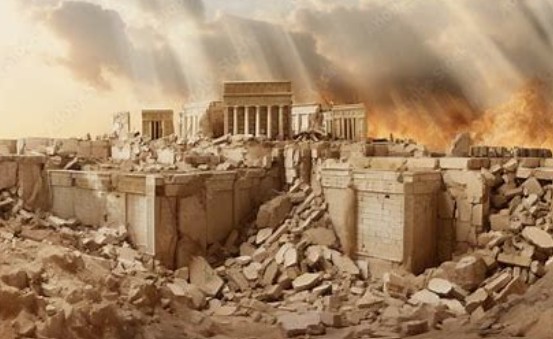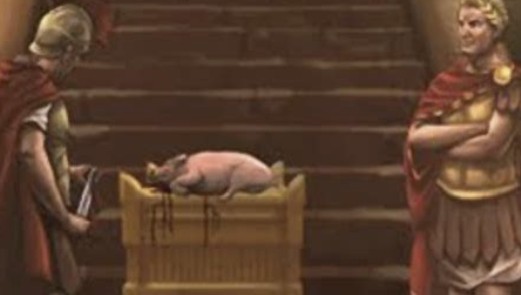The Abomination of Desolation

“Therefore when you see the ‘abomination of desolation’ spoken of by Daniel the prophet, standing in the holy place (whoever reads, let him understand), then let those who are in Judea flee to the mountains†(Matt. 24:15–16).
What does the abomination of desolation refer to?
First, whatever the abomination of desolation refers to, we can be 100% sure that it happened in the first century because Jesus said in the Olivet Discourse that it would happen within his generation.
The Olivet Discourse begins with Jesus predicting the destruction of the temple (Matt. 24:2), after which the disciples ask when it would happen: “Tell us, when will these things be? And what will be the sign of your coming and the end of the age[1]?†(v. 3). The reason why the disciples automatically thought “coming of the Lord†after Jesus mentioned the destruction of the temple is because to a biblically literate Jew of that day—which the disciples clearly were, as their writings show—such a destruction and judgment equated to a “coming of the Lord.†God the Father “came on clouds†many times in Old Testament times (Isa. 19:1, 13:9–13, Ezek. 32:7–15), and it equated to judgment and destruction. Therefore, when Jesus mentioned the destruction of the temple (Matt. 24:2), the disciples automatically thought “coming of the Lordâ€â€”and they wanted to know when it would happen (v. 3).
Then, Jesus lists the various precursors—such as false messiahs, wars and rumors of wars, the abomination of desolation, and great tribulation, etc. (vv. 4–29), and then Jesus says: “Immediately after the tribulation, they will see the Son of Man coming on clouds of glory†(v. 30). This is a reference to the destruction of the temple.
Jesus then answers the timing question: “Assuredly, I say to you [first-century disciples], this generation will by no means pass away till all these things take place†(Matt. 24:34).
A biblical generation equates to approximately forty years (see Heb. 3:8–10, Num. 14:30–34, Neh. 9:21), therefore, all these events—including the abomination of desolation—must have happened in the first century. There is no honest way around Jesus’ timing indicator.
In fact, Jesus specifically linked all these events to the destruction of the temple, which historians agree happened in AD 70.
Second, the term “abomination of desolationâ€â€”which literally means “the abomination that causes desolationâ€â€”struck terror into the hearts of first-century Jews. It induced thoughts of the Greek King Antiochus Epiphanes sacrificing a pig on the altar of the temple two centuries earlier (in 168 BC). The reason why God had allowed this desecration of the temple to happen back then was because of Israel’s gross religious failures.

And Jesus warning in AD 30 about another abomination of desolation (within a generation) meant Israel was once again guilty of gross religious failures. In fact, Jesus called the Jewish leaders of his day everything from hypocrites (Matt. 23:13) to fools (v. 17) to blind guides (v. 24) to whitewashed tombs (v. 27) to murderers (v. 31) to broods of vipers (v. 33). Jesus lamented:
“O Jerusalem, Jerusalem, the one who kills the prophets and stones those who are sent to her! How often I wanted to gather your children together, as a hen gathers her chicks under her wings, but you were not willing! See! Your house [the temple] is left to you desolate [God-forsaken]†(v. 37–38).
The abomination of desolation (in Matthew 24) has to do with first-century Israel, the Israel of Jesus’ day.
Third, the abomination of desolation had been prophesied about by the Old Testament prophet Daniel way back in around 600 BC (Dan. 9:27), and Daniel too linked it to the destruction of the temple (Dan. 9:26). Therefore, it should not have been all that shocking for the Jews of Jesus’s day to hear it was finally about to happen—within their generation (above).
Fourth, we can pinpoint exactly when the abomination of desolation happened by comparing Matthew’s account of the Olivet Discourse to Luke’s account:
Matthew: “Therefore when you see the “abomination of desolationâ€â€¦let those who are in Judea flee to the mountains†(Matt. 24:15–16).
Luke: “But when you see Jerusalem surrounded by armies…let those who are in Judea flee to the mountains†(Luke 21:20–21).
Both accounts begin with, “When you see…†However, because Luke was writing to Gentiles who would not have been familiar with the term “abomination of desolation,†he made it easier for them to understand by simply saying, “When you see Jerusalem surrounded by armies, then flee to the mountains.†And this happened at the beginning of the Jewish/Roman War of AD 67-70.
Matthew, on the other hand, was writing to Jews who were intimately familiar with the abomination of desolation from the book of Daniel; therefore, Matthew said, “When you see the abomination of desolation spoken about by Daniel, then flee to the mountains.â€
We can be sure that both Matthew and Luke were referring to the same event because of not only the terminology, but also because of the timing indicator. Both Matthew and Luke said it would happen in Jesus’ generation (Matt. 24:34 and Luke 21:32).
What specifically does the abomination of desolation refer to?
Since the abomination of desolation had to have happened in the first century, per Jesus, then there are three possibilities as to what exactly it refers to.
The first option is that it refers to the Jewish zealots who desecrated the temple just before it fell. According to the first-century historian Josephus, the Jewish zealots obtained possession of the temple in AD 67–68 and made the Holy Place a garrison and stronghold “of their tyrannous and lawless rule…while the better priests looked on from afar and wept tears of horror.â€[2] These zealots were the abomination that caused God to destroy (desolate) the temple, according to proponents of this view.
The second possibility is that the abomination of desolation refers to the Roman armies who, during the Jewish-Roman War of AD 67-70, “walked about the outer court of the temple with their pagan symbols lifted high.â€[3] With the temple engulfed in flames, the Roman armies offered sacrifices to their pagan gods. These Roman soldiers were the abomination of desolation, according to proponents of this view.
The third possibility—which is likely the correct one—is that the abomination of desolation refers to the Jewish leaders in Jesus’s day. These Jews were the abomination that caused God to destroy (or desolate) the temple. As noted above, Jesus called the Jewish leadership of his day everything from hypocrites (Matt. 23:13) to fools (v. 17) to blind guides (v. 24) to whitewashed tombs (v. 27) to murderers (v. 31) to broods of vipers (v. 33)! And Jesus said the Jewish temple was “a den of thieves†(Matt. 21:12–13) and “desolate [God forsaken]†(Matt. 23:38). This is the reason why Jesus pronounced judgment on the temple by predicting “not one stone would be left upon another†(Matt. 24:2).
As stated above, the literal interpretation of “abomination of desolation†is “the abomination that causes desolation,†and this fits the Jewish leadership of Jesus’s day well. Their abominations caused God to desolate or destroy their temple.
For more information about the events described in this article, get my book The End Is Here: How the New Testament’s Prophecies Were Fulfilled.
By Alex Polyak, Director of The Bible Fulfilled, 2/20/25
[1] The “end of the age†refers to the end of the Old Covenant age. The reason why the disciples automatically thought “end of the Old Covenant age†after Jesus mentioned the destruction of the temple was because without a temple, a vast majority of the Old Covenant’s requirements cannot be kept. Jews says there are 613 requirements, and without a temple, 2/3rds of them cannot be kept. In essence, no temple…no Old Covenant. So when Jesus predicted the destruction of the temple, the disciples automatically thought “end of the ageâ€â€¦and they wanted to know when it would happen.
[2] Gary DeMar, End Times Fiction, 84.
[3] Ibid.
